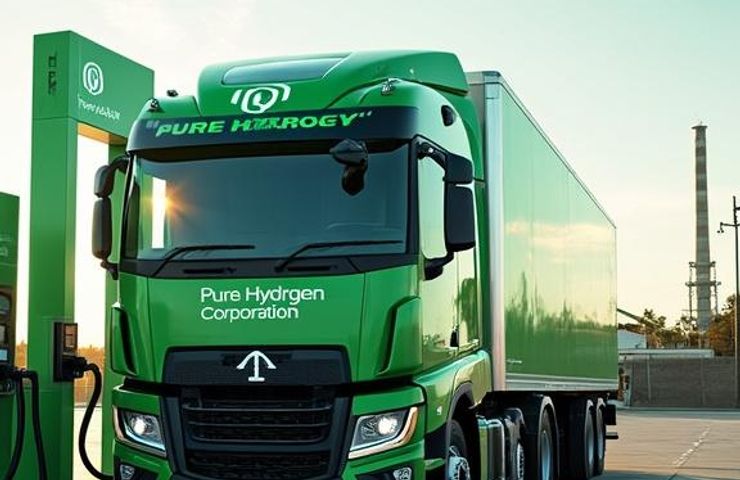
Hydrogen Fuel Cells Power Australia’s Zero-Emission Heavy Transport with A$3M+ Orders
August 11, 2025In a move that could really kick Australia’s push for zero-emission technology into high gear, Pure Hydrogen Corporation Limited (ASX: PH2) has reportedly bagged over A$3 million in fresh orders for hydrogen fuel cell vehicles. Logistics and construction operators are itching to ditch their diesel fleets, and with grant programs chipping away at the upfront costs, making the switch is starting to look a lot more doable—and a clear boost for Australia’s sustainable energy transition.
New Order Highlights
According to industry whisperers like Discovery Alert and TipRanks, here’s the lowdown on the latest contracts:
- A more-than-A$2 million deal with Scott Lovatt Transport for two TS70-400 ‘Taurus’ hydrogen fuel cell prime movers, pending government grant approvals.
- A follow-up order from Heidelberg Materials Australia for a hydrogen fuel cell concrete agitator truck, building on their March 11, 2025 ASX purchase order (due Q4 2025).
While these figures await the official nod in ASX filings, it’s clear industrial decarbonization is gaining real steam across New South Wales and Victoria.
Technical Deep Dive: How the Trucks Work
At their core, these trucks run on hydrogen fuel cells. They take hydrogen stored in high-pressure tanks, feed it into a fuel cell stack, and out comes electricity to spin the motors. The only byproduct? Water vapor. And the cherry on top is refueling times that rival diesel—critical when uptime is everything.
Most TS70-400 ‘Taurus’ models store hydrogen at 350 bar in Type IV composite tanks, balancing weight and capacity. With over 30 kg of H₂ on board, you’re looking at about 400–450 km of range under full load—though final figures hinge on payload and route conditions.
The hydrogen fuel cell concrete agitator, part of the T30-200 class, takes this further by using the same electric platform to run both the vehicle and the mixer drum. Electric auxiliaries draw power from the fuel cell, delivering smoother operation and zero tailpipe emissions on busy sites.
Australia’s first hydrogen fuel cell rear loader garbage truck, handed over to Solo Resource Recovery in February 2025, shows how well fuel cells handle city stop-start routes. Remote monitoring helps fleet managers keep on top of maintenance schedules with minimal downtime.
Comparative Landscape
Hydrogen fuel cell trucks are no longer a novelty. In Europe, Nikola and Hyzon are teaming up with big carriers for pilot fleets, and in Japan, Toyota and Isuzu have Hino fuel cell models rolling. Australia might be a bit behind, but our abundant solar and wind feed into green hydrogen projects, trimming life-cycle emissions from the outset.
The Business Case for Hydrogen Vehicles
Anyone running a fleet knows fuel and drivers eat up the budget. By nailing zero-emission technology, hydrogen trucks help companies hit sustainability targets, unlock grants, and stand out in an eco-conscious market. Fast refueling and a steady range mean fewer schedule headaches, especially where downtime directly dents profits.
Switching to hydrogen can cut fuel-related emissions by up to 75% versus diesel, depending on the hydrogen’s carbon footprint. When you power electrolysers with renewables, life-cycle emissions edge toward zero—a big win for firms wrestling with Scope 3 reporting.
That said, early deals often hinge on public support. The Scott Lovatt contract, for example, needs grant funding. It’s a reminder that smart policies are crucial until economies of scale bring down the cost of electrolysers and fuel cell stacks. As electrolysis scales up, total cost of ownership should align with diesel by decade’s end.
Funding and Policy Drivers
NSW and Victorian governments now cover up to 30% of vehicle and refueling station costs. At the federal level, the National Hydrogen Strategy aims for 200,000 tonnes of green hydrogen annually by 2030. But industry experts warn incentives need to grow with the market—to avoid funding cliffs that could stall progress.
Traction and Track Record
- February 2025: Australia’s first hydrogen fuel cell garbage truck delivered to Solo Resource Recovery, logging solid performance in early tests.
- March 2025: ASX announcement for the first HFC concrete agitator from Heidelberg Materials, due Q4 delivery.
- June 2025: Taurus prime mover rolled out to Barwon Water in Victoria for water haulage trials.
- August 2025: Reports of new orders topping A$3 million, including the Scott Lovatt and Heidelberg follow-up deals (pending ASX confirmation).
This track record shows Pure Hydrogen exploring use cases from waste collection to heavy construction, laying the groundwork for wider commercial rollout both locally and overseas.
International Expansion Ambitions
Pure Hydrogen isn’t stopping at home. They’ve flagged a US$28 million distribution agreement in Mexico for early 2026, aiming to ship hydrogen equipment and grow their global footprint. This push can diversify revenue streams and speed up tech maturation through higher production volumes.
Looking Ahead: Infrastructure and Scale-Up
Rolling out hydrogen trucks at scale depends on deepening hydrogen infrastructure. That means more refueling stations, robust supply chains for on-site and cross-border transport, and investment in production facilities, pipeline networks, and storage terminals. As more fleets sign up, momentum will build for Australia’s sustainable energy transition.
Policy alignment between state and federal agencies will be key. Upfront cost grants, clear emissions targets, and sensible carbon pricing can nudge the economics further toward hydrogen. For Pure Hydrogen, this runway offers the chance to optimize manufacturing, chase economies of scale, and ultimately bring prices down.
Final Thoughts
We’re at a tipping point: hydrogen fuel cells are moving from pilots to real-world operations across Australia’s heavy vehicle sector. With everything from agitators and prime movers to refuse trucks hitting the road, the versatility of zero-emission technology is on full display. The real test now is coordination—energy producers, fleet operators, and regulators all need to play their part. If they do, we’ll see robust hydrogen infrastructure underpinning Australia’s low-carbon, sustainable energy future.



 With over 15 years of reporting hydrogen news, we are your premier source for the latest updates and insights in hydrogen and renewable energy.
With over 15 years of reporting hydrogen news, we are your premier source for the latest updates and insights in hydrogen and renewable energy.